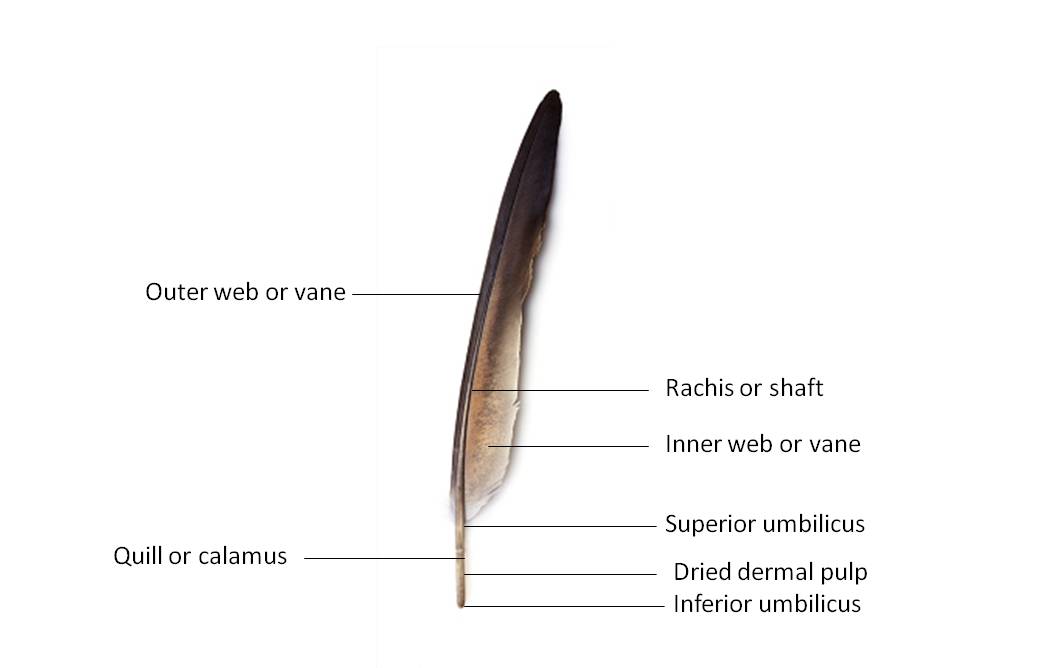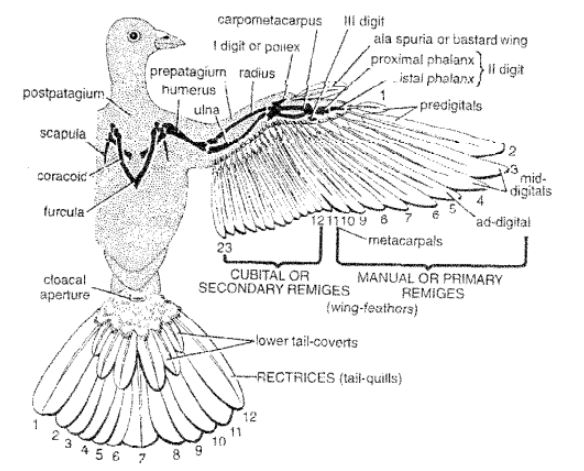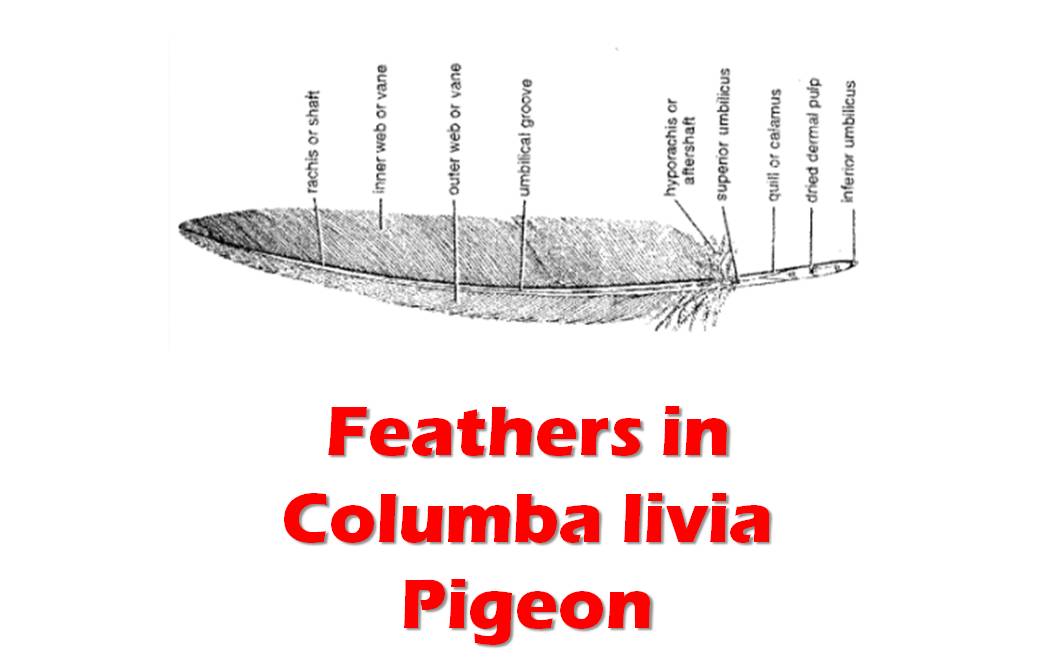In this article on pigeons, we will learn about the structure, types, development, and uses of feathers in pigeons (Columba livia). Columba livia is the scientific name of the Indian Rock Pigeon. Feathers play a crucial role in pigeons, as they do in other bird species. Pigeons have a unique feather structure that allows them to fly efficiently and provides various other functions.
What is Feather?
- It is a kind of exoskeleton of any kind of bird.
- Only Aves has this characteristic of the presence of feathers.
- The arrangement and distribution of feathers in the body are known as pterylosis.
- They are light, elastic, waterproof, and most important in flight.
- Different feathers of different birds have different colors due to the presence of pigments.
Feathers in Pigeon
- Pigeon or Columba livia has four types of feathers and they are flight feathers, contour feathers, filoplumes, and down feathers.
- Each feather is divided into two parts the axis and the vane. The axis is further divided into two regions the quill and the rachis.
- The flight feathers of wings are known as remiges.
- The flight feathers of the tail are known as rectrices.
- A newly hatched pigeon baby has down feathers only.
- Down feathers have no rachis.
- Down feathers are being replaced by contour feathers as long as the bird grows into an adult.
Diagram of Feathers in Pigeon

Fig: Diagram of feathers in the pigeon (Columba livia)
Structure of Feathers in Pigeon
A typical pigeon feather has two parts. They are 1. The axis or main stem, and 2. The vane or vexillum.
1. The axis
- It is the hard and solid part of the feather which runs almost the middle part of the feather.
- It is again divided into two regions. They are 1. Quill or Calamus, and 2. Rachis or Shaft.
Quill
-
-
- It is hollow, tubular, and semi-transparent.
- It is the proximal lower portion of the axis.
- The base of the quill is inserted into a pit or epidermal follicle of the skin.
- At the lower portion of the quill, there is a small opening called the inferior umbilicus.
- Nutrients and pigments are supplied through the inferior umbilicus to a developing feather.
- At the junction of the quill and the rachis, there is another opening called the superior umbilicus.
- Near the superior umbilicus, a small tuft of soft feathers is present which are called hyporachis or after-shaft.
- Hyporachis covers the superior umbilicus.
-
Rachis
-
-
- The distal upper portion of the axis is called the rachis.
- It is solid, opaque, and roughly quadrangular in the transverse section.
- It is filled with pith cells.
- A longitudianl furrow runs along the ventral portion of the rachis throughout its length called the Umbilical groove.
-
2. The Vane
- It is the expanded membranous part of the feather.
- The rachis divides it into two unequal parts.
- The proximal region of the vane is broader than the distal region.
- The vane is formed by a series of numerous parallel thread-like structures, the barbs or the rami.
- Each barb gives rise to a double row of filaments called barbules or radii.
- The barbules are of two types. They are the distal barbules and the proximal barbules.
Types of Feathers in Pigeon

fig : Arrangement of the feathers in pigeon.
There are four types of feathers present in pigeons and they are quills or flight feathers, contour feathers, filoplumes, and down feathers.
1. Quills or Flight Feathers
- These are the strong and large feathers of pigeons.
- The pigeon uses these feathers for flight.
- These feathers have comparatively strong rachis.
- Quills or flight feathers are further classified into three types and they are remiges, rectrices, and coverts.
Remiges
-
-
- Flight feathers of wings are called remiges (singular remex).
- It is also termed as pinions or wing quills.
- Their inner or posterior half of the vane is slightly broader than the outer or anterior half.
- Each wing of a pigeon contains 23 remiges.
- Eleven remiges are attached to the hand. They are called primaries or manuals.
- Of these 11 manuals, the first four feathers are attached to the second digit and they are termed as digitals.
- Of these four digitals, two of them are attached to the distal phalanx and termed as predigitals. Rest two are attached to the proximal phalanx and termed as middigitals.
- The remaining seven manuals are attached to the metacarpal and termed as metacarpals.
- The remaining twelve remiges are attached to the forearm and called secondaries or cubitals.
-
Rectrices
-
-
- Flight feathers of tail are called rectrices (singular rectrix).
- They are also termed as tail quills.
- There are 12 rectrices present in pigeon.
- These rectrices form semi circle, fan like manner on the tail.
- These feathers help the bird as a brake and in steering the flight.
-
Coverts
-
-
- Bases of remiges are covered by upper and under wing-coverts.
- Bases of rectrices are covered by upper and under tail-coverts.
- Coverts are smaller in size than the remiges and rectrices but structurally same.
- They close the interstices between quills of flight feathers, thus presenting a continuous area to oppose the buoyancy of air.
-
2. Contour Feathers
- These feathers form the general body covering.
- They are smaller and woolly feathers.
- They have poorly developed barbules.
- Contour feathers provide a smooth surface to the body.
- They make a good heat-conserving layer.
3. Filoplumes (Hair feathers or pin feathers)
- These are the small, delicate, and hair-like feathers.
- These feathers are present all over the body.
- They are seen in the plucked pigeon.
- They consist of a short calamus and a long thread-like rachis with a few weak barbs and barbules at the free tip.
4. Down Feathers (plumules)
- These are small, soft, and woolly feathers present only in a newborn baby.
- They have no rachis.
- They form the natal covering of the newly hatched birds.
- Adult pigeons do not have down feathers. The down feathers are being replaced by the contour feathers as the bird grows into the adult.
Uses of Feathers in Pigeon
Feathers have several important and decorative functions for pigeons. The uses of the feathers in pigeons are given below:-
1. Protection
Feathers are a durable covering of the pigeons and protect them from any mechanical and physiological injury.
2. Heat Retention
Heat retention is one of the most important functions of the feathers for pigeons. The birds can maintain 104° to 112°F with the help of feathers in any kind of weather. During cold weather, feathers help to prevent heat loss from the body.
3. Organ of Flight
This is the most important function of feathers. Birds or pigeons can fly with the help of feathers. Feathers are light, elastic and horny structures. Pigeons fly in the air with the help of flight feathers and flight muscles.
4. Protective Coloration or Camouflage
As pigeons or other birds have different pigments, they have different colored feathers which help them camouflage and protect the birds from their enemies.
5. Sex Determination
Usually, the male birds have more attractive feathers than the females which help them in attracting the females during the breeding season.
6. Natal Covering
Down feathers are of special importance as natal covering in birds.
7. Formation of Nest
Pigeons as well as other birds use their feathers in the formation of nests to make them more comfortable.
————- THE END ————
Read More:
- Muscular System of Columba livia | Pigeon | Diagram
- Digestive System of Columba livia | Pigeon | Diagram | Note
- Air Sacs of Pigeon | Bird | Columba livia | Diagram | Note
- Skin and Exoskeleton of Columba livia | Pigeon | Diagram
- External Morphology of Columba livia | Pigeon | Diagram
- General Characters of All Classes of Vertebrates.
- The Sound Producing Organ in Birds | Syrinx | Diagram | Note
Reference:

